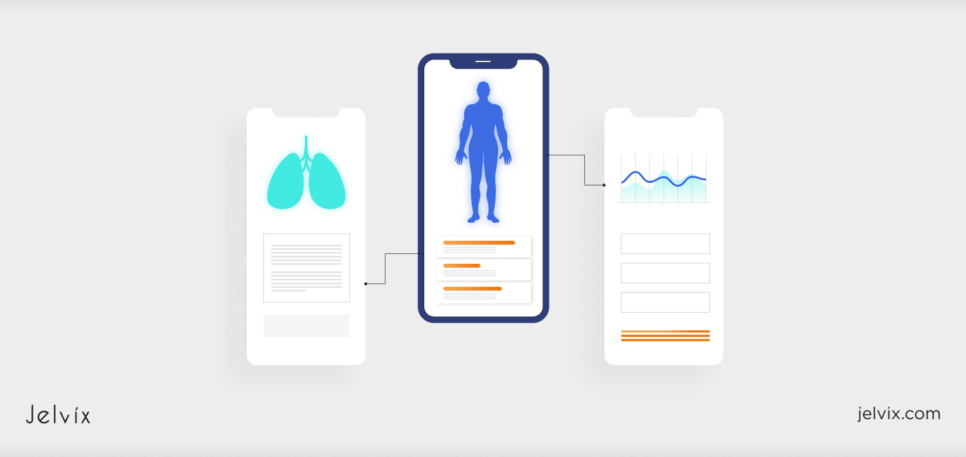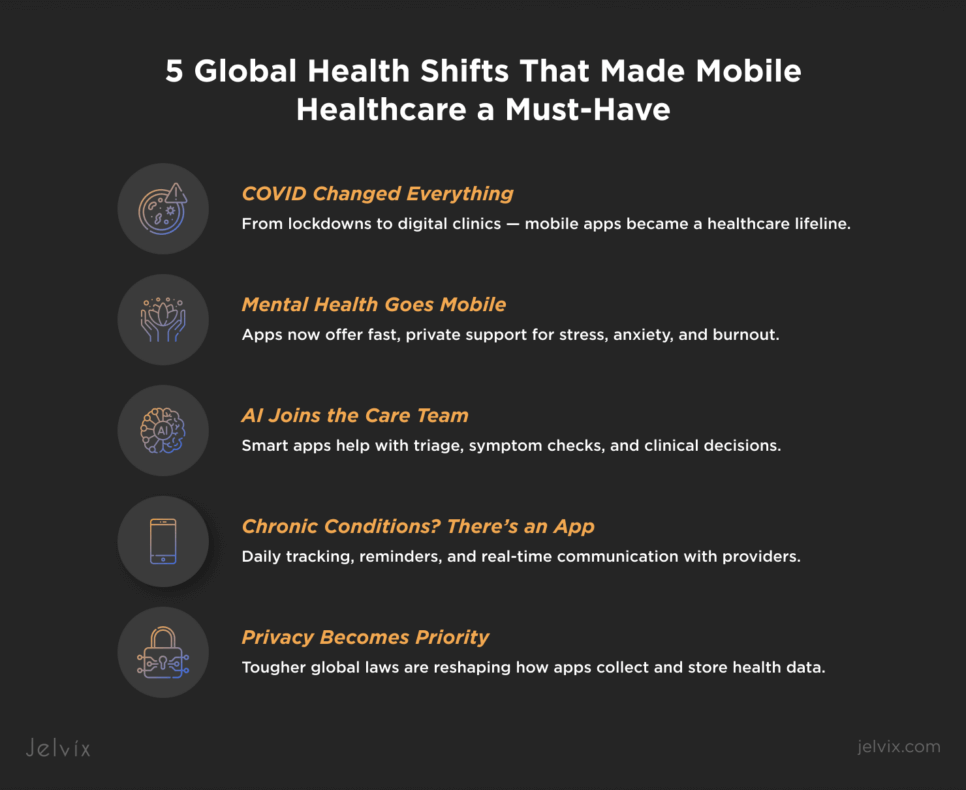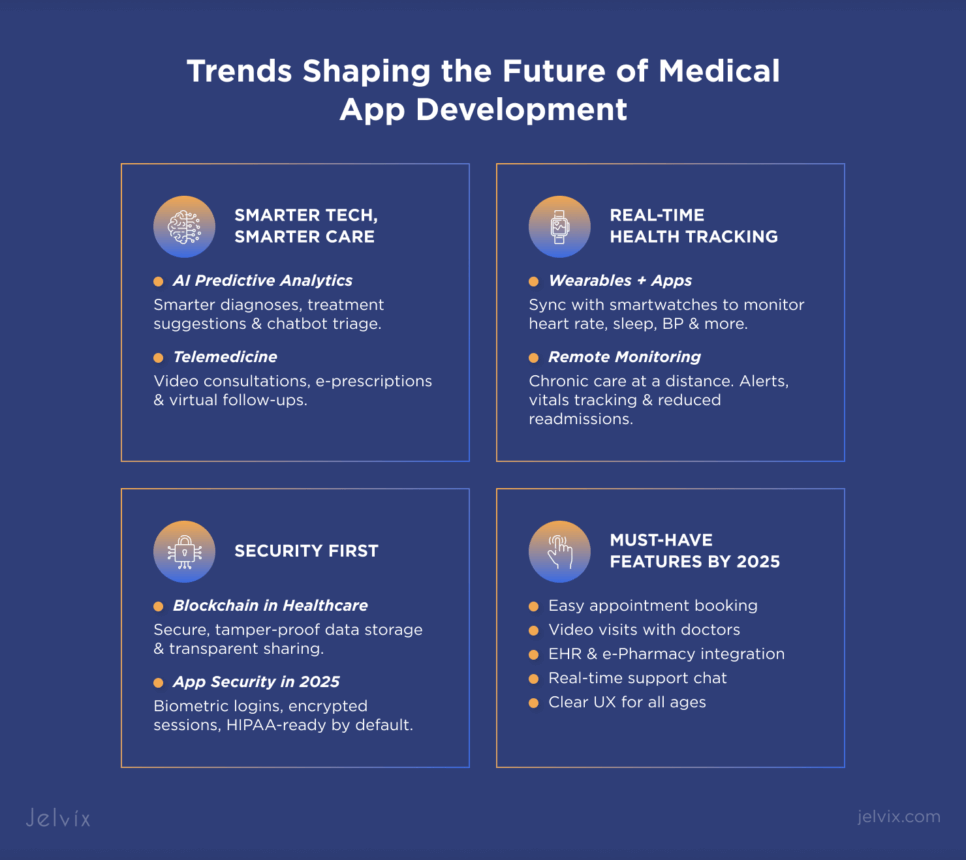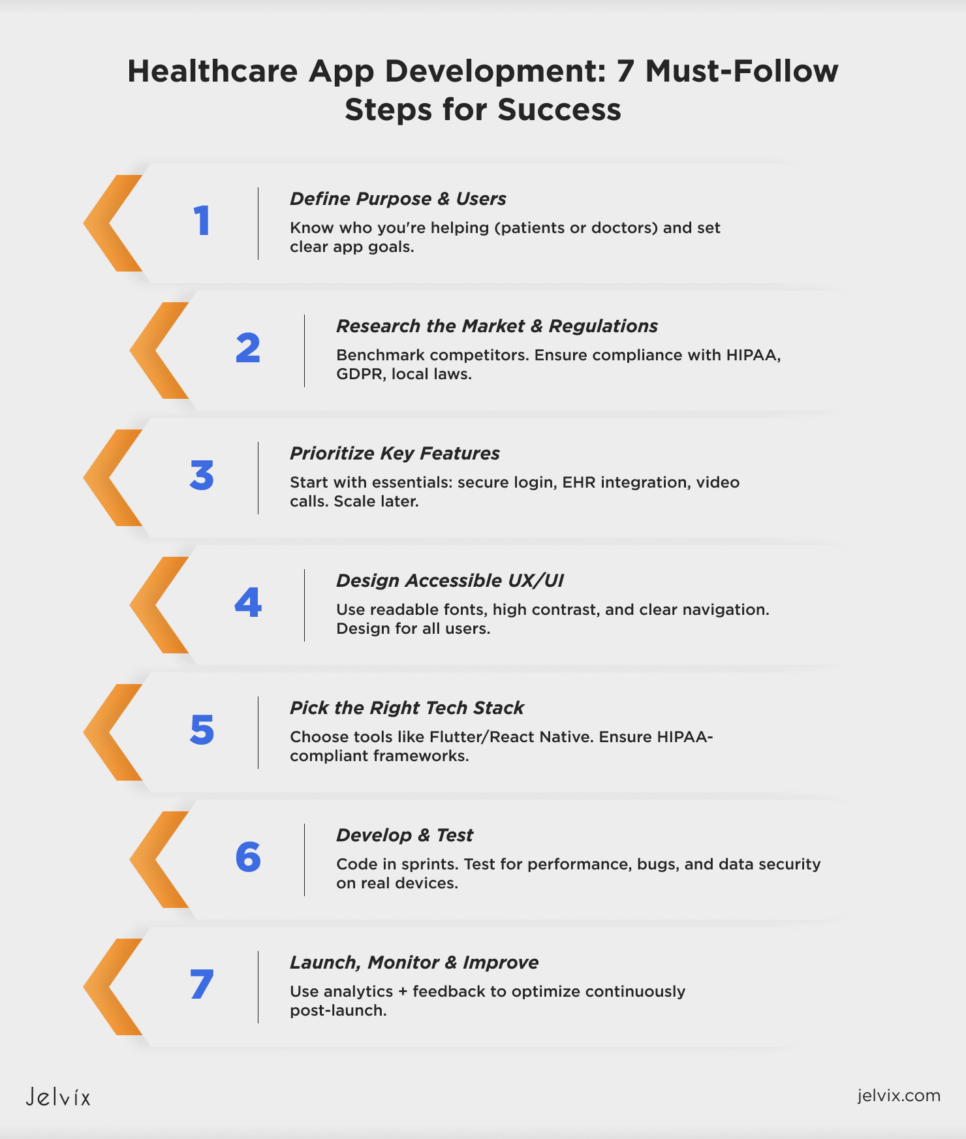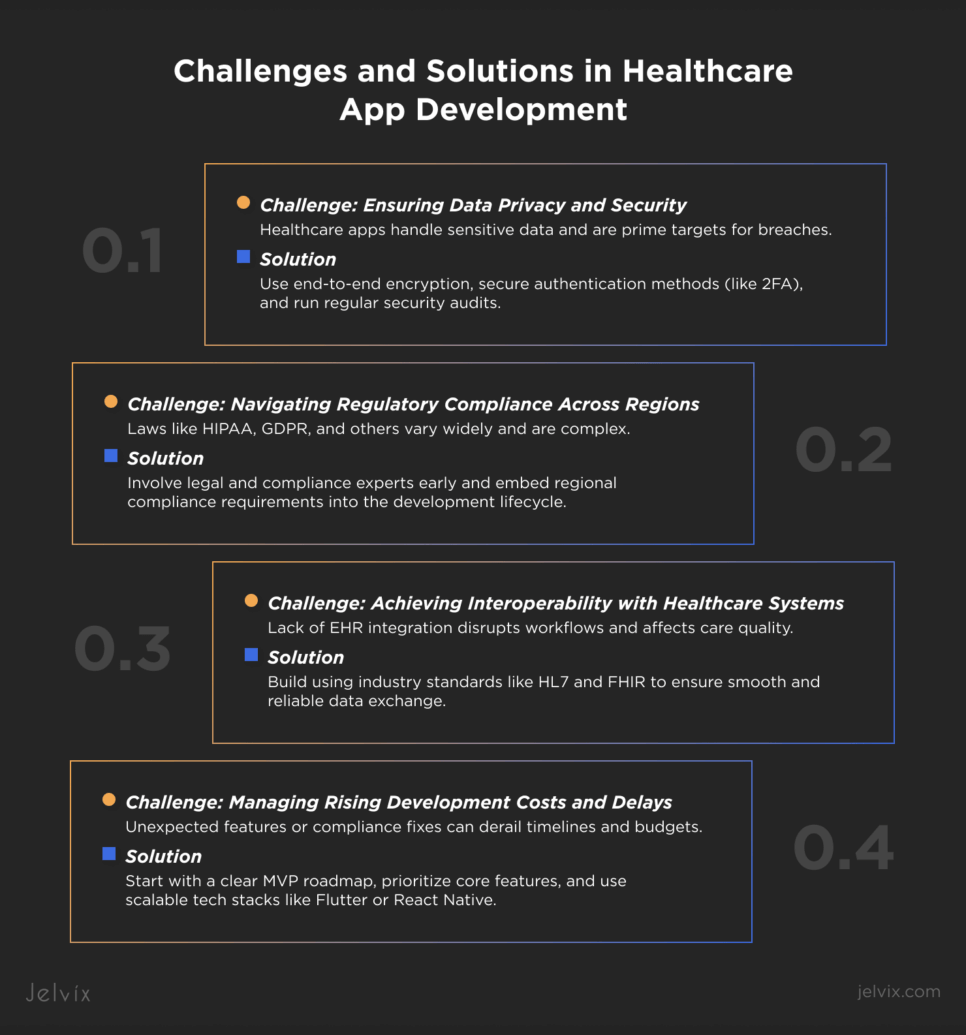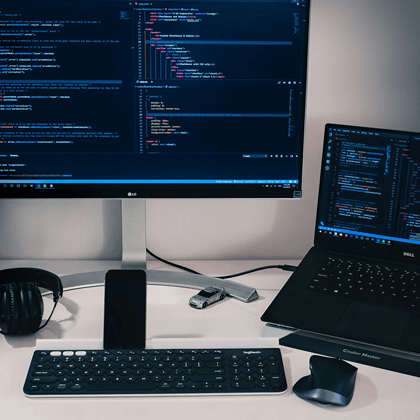Mobile apps are transforming the way healthcare is delivered, with a greater emphasis on remote care, real-time data, and patient-centered tools. This convenience leads to the wider adoption of medical apps, with approximately 43% of the US population having used these apps as of 2024.
Although businesses invest heavily in healthcare mobile app development, building a comprehensive solution isn’t easy. You must comply with strict data privacy laws, integrate seamlessly with existing healthcare systems, and design a solution that works smoothly for users of all ages.
If you want to know how to develop a healthcare mobile app in 2025 that is HIPAA-compliant, efficient, and easy to use, read this guide. You’ll find out more about the must-have features, key trends, and costs of building a medical application.
The Significance of Healthcare Application Development for Medical Companies
Healthcare mobile apps have come a long way. Initially, they assisted with basic tasks, such as booking appointments and setting reminders to take medication. Now, they do much more, such as tracking vital signs, connecting patients to doctors, and even utilizing AI in healthcare to aid in early diagnosis.
Many include remote care, real-time health tracking, and AI chat support. 5G enables faster video calls and data sharing. Apps also help with mental health by utilizing gamification to boost engagement and provide quick access to medical records. These trends aim to make care more connected and patient-friendly.
The Current State of Digital Health App Development
The global market for mHealth apps is expected to reach USD 88.70 billion by 2032, as more people use smartphones and seek easy ways to track their health or consult a doctor from home.
Global Health Events That Impact the Adoption of Mobile Technology in Healthcare
Over the past few years, global health challenges have prompted many providers to adopt custom enterprise software development for safer, faster, and more flexible care solutions, including mobile applications.
Post-COVID Pandemic
COVID-19 changed how people get healthcare. During lockdowns, mobile apps helped doctors and patients stay connected, and many continue to use them for video calls, symptom tracking, and sharing test results.
Mental Health Crisis
More people are turning to apps for help with stress, anxiety, and depression, and the global market for mental health apps will keep expanding in the years ahead.
Rise of AI in Healthcare
Artificial intelligence (AI) is now integrated into many healthcare applications. Some use chatbots to answer health-related questions, while others assist doctors in making decisions by presenting possible diagnoses or treatment options.
Managing Chronic Conditions
Apps also help people manage long-term illnesses, such as diabetes, heart disease, or asthma. They remind users to take medicine, track symptoms, and communicate with medical professionals.
Stronger Data Privacy Rules
As health apps collect more personal data, governments are making stricter rules. New laws are being drafted to protect users and ensure that apps don’t share data without their permission.
Trends in Medical App Development To Expect in the Upcoming Years
New tools, including advanced patient portals and wearable technology, are making healthcare more innovative and more efficient. Businesses planning to build healthcare apps should pay attention to key trends that impact the adoption.
AI Predictive Analytics in Healthcare Apps
Apps can now utilize AI to identify patterns in patient data, recommend treatment options, or guide users through symptom checkers and chatbots, enabling doctors to make more informed decisions.
Learn how predictive analytics in healthcare and remote patient monitoring (RPM) work together to improve care delivery, reduce risks, and personalize treatment.
Telemedicine Tools
Video visits and online consultations are now a fundamental part of care. Apps connect patients with doctors, help them refill prescriptions, and track their treatment progress.
Wearable Technology in Healthcare
More apps are working with smartwatches and health trackers. These devices collect real-time data, such as heart rate, sleep patterns, and blood pressure, enabling users and doctors to monitor their health over time.
Blockchain for Data Security
Healthcare apps handle a significant amount of sensitive information. Utilizing blockchain for business and medical app development helps ensure patient data remains safe and tamper-proof. It also makes sharing data more transparent.
Successful Examples of Innovative Healthcare Apps
Many companies are already utilizing new technologies to enhance care and streamline health management. Experts from Jelvix can demonstrate how advanced technology, smart data utilization, and best practices for healthcare app development can result in modern solutions that transform the approach to care.
Cancer Treatment Assistant
Jelvix experts developed an innovative tool to support cancer treatment using AI and the FHIR data standard. It helps doctors to manage complex patient data and make better decisions based on past cases, treatment outcomes, and clinical guidelines.
Remote Patient Monitoring
Another Jelvix solution enables doctors to track patients with chronic conditions remotely. The app collects health data, such as blood pressure and glucose levels, sends alerts when abnormalities occur, and helps reduce hospital readmissions.
Key Healthcare App Features To Consider in 2025
Your medical app development efforts must be secure and helpful throughout the entire care journey. By 2025, these features are expected by users and will be required by the industry.
User Authentication and Secure Login
Modern apps utilize secure logins, such as two-factor authentication, biometric identifiers like fingerprint or face recognition, and encrypted sessions to safeguard patient data.
Appointment Scheduling and Reminders
Apps should let users easily book, reschedule, and cancel appointments. Automated reminders reduce missed visits and help patients stay consistent with care.
Telehealth and Video Conferencing
Telehealth tools that help patients to meet with doctors via video save time, improve access to care, and are particularly helpful for follow-up appointments.
EHR Integration
EHR data integration helps doctors to view patient history, test results, and prescriptions directly within their app. This helps improve accuracy and speed up decision-making.
Explore a step-by-step guide to successful EHR implementation—from planning and vendor selection to integration, training, and long-term adoption.
Prescription Management and E-Pharmacy Integration
Users need tools to view prescriptions, request refills, and order medications online. This feature promotes better medication adherence and reduces the need for trips to the pharmacy.
Real-Time Chat and Support
Instant messaging with healthcare teams, AI assistants, or support staff enables users to obtain quick answers. It helps manage chronic conditions or post-visit follow-ups.
User-Centric Design
Apps should be easy to understand and navigate. A user-focused design features clear labels, large buttons, and straightforward layouts that are accessible to all ages and abilities.
On-Premise vs Cloud Apps
Cloud-based apps offer easier updates, better scalability, and remote access. On-premise apps provide more control and data ownership, but they require more IT resources.
Blockchain App Security
Blockchain technology adds a secure way to store and share data. It ensures transparency, protects against tampering, and helps meet strict healthcare privacy standards.
Healthcare App Development Process: A Step-By-Step Guide for Providers
Creating a healthcare mobile app requires careful planning and the right team, where every step must adhere to strict standards and prioritize user needs.
1. Define the Purpose and Target Users
Start by deciding what your app is meant to do, such as helping patients manage chronic conditions or enabling doctors to track treatment progress efficiently. The more precise your goals are now, the easier it is to measure success later.
2. Do Market and Compliance Research
Examine what similar apps are doing and what users are requesting. Study privacy laws, such as HIPAA and GDPR, as well as local regulations. Getting this right from the beginning helps avoid legal issues and builds user trust.
3. List Key Features
Create a list of features that align with your app’s goals. Include core and most critical functions, such as secure login, integration with EHR systems, or video calls, first. You can always add more advanced tools like wearable integration or AI chatbots later.
4. Design the UX and UI
Collaborate with designers to develop a clear and straightforward layout. The app should be easy to navigate, so use readable fonts, high-contrast colors, and clear icons to improve accessibility.
5. Choose the Right Tech Stack
Select tools and frameworks that align with your budget, timeline, and performance requirements. For example, Flutter or React Native can speed up development for both iOS and Android. Ensure your tools comply with healthcare security standards.
6. Develop and Test the App
Build the app in sprints, testing each part as you go on real devices, not just emulators. Include functional testing, performance checks, and security testing to spot bugs and protect user data.
7. Launch, Monitor, and Improve
Track how users interact with your app. Use analytics to monitor performance and user behavior. Collect feedback, fix issues, and plan updates to improve the experience over time.
Tools and Technologies Commonly Used in Top mHealth Apps
Modern healthcare apps are developed using tools that prioritize security, speed, and scalability.
For the frontend, many teams use Flutter or React Native to build cross-platform apps, or Kotlin and Swift for native iOS and Android development. On the backend, common choices include Node.js, .NET, and Django to handle data processing and user management.
Databases such as PostgreSQL, MongoDB, or Firebase are used to securely store health records and user data. Cloud platforms such as AWS, Google Cloud, and Microsoft Azure help scale the app and offer healthcare-specific compliance tools.
To connect with hospitals or clinics, developers often use FHIR and HL7 standards. For security, they apply OAuth 2.0 for user access and AES-256 encryption to protect data.
How To Ensure Compliance and Security During Your Telemedicine App Development
Healthcare apps deal with private and sensitive information. Understanding key regulations will help you avoid legal risks and build trust with users. If you are unsure, consult with a legal expert in healthcare compliance.
HIPAA in the U.S.
US-based clinics utilize the Health Insurance Portability and Accountability Act to safeguard patients’ personal health information.
It requires secure transmission and storage of data, strong user authentication, role-based access control, backup systems, and disaster recovery plans, as well as formal agreements with third-party vendors who handle health data to ensure HIPAA compliance in mobile apps.
GDPR in the EU
The General Data Protection Regulation (GDPR) is the primary privacy law governing data protection across the European Union (EU). It protects all personal and health information, providing users with complete control over their data. To comply, apps must clearly explain why data is being collected and ask for user consent before storing or sharing it. Users have the right to request the deletion of their information at any time.
Other Regional Regulations
Many other countries are introducing or strengthening healthcare data privacy laws:
- PIPEDA in Canada;
- PDPA in Singapore and Thailand;
- Data Protection Act (DPA) in the UK (post-Brexit);
- New Health Information Privacy Acts in U.S. states like California and New York.
When launching an app in multiple countries, businesses must ensure it complies with all applicable laws, not just one.
Best Practices for Data Protection
Users trust your app with sensitive health information, and even the most minor data leak can lead to severe legal and reputational damage. Ensure that you follow proven practices to keep their data safe.
Use Strong Data Encryption
Encrypt all health data, both stored and in transit. Use end-to-end encryption for messages and employ strong encryption protocols, such as AES-256, for storing sensitive medical records and personal details.
Secure Login and Authentication
Implement multi-factor authentication, strong passwords, biometric login, and other robust authentication methods to add an extra layer of security to user accounts.
Role-Based Access Control
Limit what users can see or do based on their role. This helps reduce the likelihood of sensitive data being misused or exposed.
Keep Audit Logs
Track user actions within the app. Logs should record who accessed what data and when. This helps detect unusual behavior, supports investigations after security events, and is required by many healthcare regulations.
Regular Security Testing and Updates
Test the app using tools like vulnerability scanners and manual code reviews. Include penetration testing to simulate attacks. Also, update your app regularly to patch known security issues.
Use Secure APIs and Third-Party Tools
When connecting with other systems, use secure APIs. Always verify that third-party tools adhere to healthcare data standards and implement proper authentication.
Cost Analysis and ROI
Developing a healthcare app can be a significant investment, but with the proper planning, it can deliver strong returns. Understanding what affects your healthcare app development cost will help you stay on budget and build a successful product.
App Complexity
Apps with advanced features, such as AI, EHR integration, or remote monitoring, require more time and budget than simple appointment booking apps.
Platform Choice
Building for both iOS and Android costs more than choosing one. Cross-platform tools like Flutter can reduce costs, but they may not be suitable for every app.
Design Requirements
A simple design is more cost-effective, but healthcare apps must be user-friendly for all age groups. If you want a custom interface with accessibility features, expect higher costs.
Third-Party Integrations
Connecting to systems like EHRs or payment platforms increases complexity and may involve additional setup and licensing fees.
Security and Compliance
Meeting healthcare regulations requires encryption, secure storage, and legal reviews, all of which raise development costs.
Maintenance and Updates
After the app is launched, you’ll still need to spend on updates, security patches, bug fixes, and new features. Long-term maintenance is a significant component of the overall cost.
Strategies for Monetization and Measuring Your App’s Success
After launching your healthcare app, it’s crucial to have a plan in place for generating revenue and tracking its performance.
A common way to generate revenue is by charging users for access to extra features. These include telehealth consultations, personalized care plans, or priority support within the app.
Apps can also offer upgrades that users pay for only when needed, such as advanced health tracking, mental wellness tools, or one-on-one medical consultations.
For larger-scale use, the app can be licensed to hospitals, insurers, or employer healthcare programs. This B2B model allows organizations to offer the app to patients or staff as part of their care solution.
To see the financial return, compare revenue and savings to your total investment. This includes development, updates, and support. Tracking ROI helps with future budgeting and product planning.
Challenges and Solutions of Developing Patient Engagement Apps
Developing a healthcare app comes with unique challenges. From protecting data to meeting healthcare rules, these issues require careful planning and the right solutions to keep the project on track.
Common Obstacles in Development and Deployment
Before launching a healthcare app, it’s important to understand the challenges that can slow down development or create risks. These obstacles affect everything from security and legal compliance to technical performance and project costs.
Ensuring Data Privacy and Security
Healthcare apps handle highly sensitive personal and medical data. A single breach can damage user trust and lead to serious legal trouble. Developers must use strong encryption, secure authentication, and regular security testing to protect user information from the start.
Navigating Regulatory Compliance Across Regions
Healthcare privacy laws vary by country and even by state. Regulations like HIPAA and GDPR have strict requirements for how apps collect, store, and share health data. Developers need to understand the rules for each region where the app will be used and build in compliance from day one.
Addressing Interoperability with Existing Healthcare Systems
Many healthcare providers already use EHR systems and other digital tools. Your app needs to connect with them smoothly, or it won’t be useful. Lack of interoperability can cause delays, errors, or lost data, especially in patient care. Building around standards like HL7 and FHIR helps improve system integration.
Managing Development Costs and Timelines
The healthcare app development cost can rise quickly as new features, rules, or technical challenges delay the launch. To stay on track, teams should build a clear roadmap, prioritize core features, and use tools that support fast and secure development.
Expert Tips for Overcoming Top App Development Challenges
Building a healthcare app entails strict regulations and high user expectations. To avoid delays and costly mistakes, it helps to follow proven strategies.
Involve Legal and Security Experts Early
Bring in compliance and cybersecurity specialists at the start of your project. This helps ensure your app complies with regulations such as HIPAA and GDPR. Early guidance also reduces the risk of costly rework later.
Use Trusted Healthcare Standards
Build your app using industry standards like FHIR and HL7. These help your app set up smooth EHR integration, making data exchange faster and more reliable.
Choose the Right Tech Stack
Select tools and platforms that support strong security, fast development, and easy updates. Frameworks like React Native or Flutter can accelerate development, while cloud platforms like AWS or Azure facilitate scalability and compliance.
Focus on a Strong First Release
Instead of trying to build every feature at once, start with a solid core version of the app. Include only the most essential features, and plan to expand based on user feedback. This helps control costs and launch faster with fewer risks.
How a Healthcare Mobile App Development Company Can Support Your Goals
If developing a mobile app from scratch is on your to-do list, partnering with an experienced healthcare app development company can save you time and money. From the initial idea to launch and ongoing support, a strong tech partner can guide you through key decisions—like selecting the right features, ensuring compliance, and scaling your solution as your business grows.
If you want to optimize your healthcare app development cost, experts from Jelvix can help you calculate the quote. Reach out for a personalized consultation on custom medical app development based on your business needs and budgeting possibilities.
Turn complex goals into real outcomes.
Partner with a software development team tailored to your needs—for full control, flexibility, and results.


